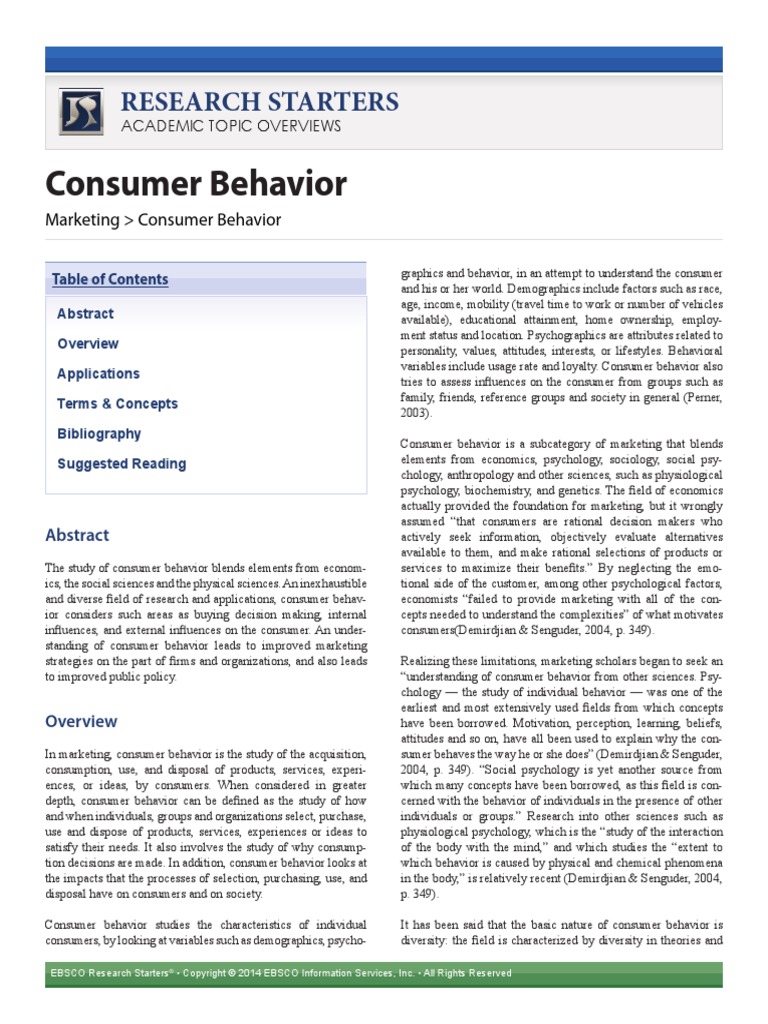
Jan 19, · From Sweetheart to Scapegoat: Brand Selfie-Taking Shapes Consumer Behavior by Reto Hofstetter, Gabriela Kunath, and Leslie K. John Using a dataset of more than , user reviews on Yelp, this paper describes a series of eight studies exploring how brand selfie-taking affects consumers’ behavior and sense of connection toward a brand View Consumer Behaviour Research Papers on blogger.com for free This paper explores the possible uses of online news discussions that emerge following the publication of news on the Internet. It is suggested that this medium provides those investigating consumer behaviour with a new, previously unavailable, source of information (at almost no direct cost)
Consumer Behaviour Research Papers - blogger.com
Try out PMC Labs and tell us what you think. Learn More. The COVID pandemic and the lockdown and social distancing mandates have disrupted the consumer habits of buying as well as shopping. Consumers are learning to improvise and learn new habits. For example, consumers cannot go to the store, so the store comes to home. While consumers go back to old habits, it is likely that they will be modified by new regulations and procedures in the way consumers shop and buy products and services, research papers on consumer behavior.
New habits will also emerge by technology advances, changing demographics and innovative ways consumers have learned to cope with blurring the work, leisure, and education boundaries. The purpose of this research paper is to examine the impact of Covid pandemic on consumer behavior.
Will the consumers permanently change their consumption habits due to lockdown and social research papers on consumer behavior or will they go back to their old habits once the global crisis is over? Will there be new habits consumers will acquire due to new regulations related to air travel, shopping at the shopping centers and attending concerts and sports events?
Will consumers find that going to a store or attending an event in person is much of a hassle, and therefore, it is better to let the store or the event come to home? To some extent, this has been happening for quite some time in sports tournaments and entertainment by broadcasting them on television and radio. All consumption is location and time bound. Consumers develop habits over time about what to consume, when and where Sheth, aSheth, b.
Of course, this is not limited to consumption. It is also true of shopping, searching for information and post consumption waste disposal. And consumer behavior is highly predictable, and we have many good predictive models and consumer insights based on past repetitive buying behavior at the individual level. While consumption is habitual it is also contextual. Context matters and there are four major contexts which govern or disrupt consumer habits.
The first is change in the social context by such life events as marriage, having children and moving from one city to another.
The social context includes workplace, community, neighbors, and friends. The second context is technology. And as breakthrough technologies emerge, they break the old habits. The most dramatic technology breakthroughs in recent years are smart phones, internet and ecommerce.
Online search and online ordering have dramatically impacted the way we shop and consumer products and services. A third context that impacts consumption habits is rules and regulations especially related to public and shared spaces as well as deconsumption of unhealthy products.
For example, consumption of smoking, alcohol, and firearms are regulated consumption by location. Of course, public policy can also encourage consumption of societally good products and services such as solar energy, electric cars, and mandatory auto and home insurance services and vaccines for research papers on consumer behavior. The fourth and less predictable context are the ad hoc natural disasters such as earthquakes, hurricanes, and global pandemics including the Covid pandemic we are experiencing today.
Similarly, there are regional conflicts, civil wars as research papers on consumer behavior as truly global wars such as the World War II, cold war, and Great Depression of the late twenties and the Great Recession of — All of them significantly disrupted both consumption as well as production and supply chain. The focus of this paper is to examine both the immediate as well as the long-term impact of Covid on consumption and consumer behavior.
As mentioned before, all consumption and consumer behavior are anchored to time and location, research papers on consumer behavior.
Since World War II, more and more women have been working resulting in reduction of discretionary time. It is estimated that today more than 75 percent for all women with children at home are working fulltime. This has resulted in time shortage and time shift in family as well as personal consumption.
Monday through Fridays, no one is at home between 8am to 5 pm for service technicians research papers on consumer behavior do installations and maintenance of appliances as well as repairs of broken heating and cooling systems. The supplier has to make appointments with the household to ensure there will be someone at home to open the door. There is also time shortage as the discretionary time of the homemaker is now nondiscretionary due to her employment.
This time shortage has resulted in consumers ordering online and have products delivered at home. Similarly, vacations are no longer two or three weeks at a time but are more minivacations organized around major holidays such as Easter, Christmas, Thanksgiving, Memorial Day, and Labor Day extended weekends. This has resulted in location constraint and location shortage. We have mobility shift and mobility shortage, research papers on consumer behavior.
Working, schooling and research papers on consumer behavior all have shifted and localized at home.
At the same time, there is more time flexibility as consumers do not have to follow schedules planned for going to work or to school or to shop or to consume. Shortage of space at home is creating new dilemmas and conflicts about who does what in which location space at home.
As homo sapiens, we are generally more territorial and each one needs her or his space, we are all struggling with our privacy and convenience in consumption. Consumers are stockpiling essential products for daily consumption resulting in temporary stockouts and shortages. This includes toilet paper, bread, water, meat, disinfecting and cleaning products. Hoarding is a common reaction to managing the uncertainty of the future supply of products for basic needs. Hoarding is a common practice when a country goes through hyperinflation as it is happening in Venezuela.
In addition to hoarding, there is also emergence of the gray market where unauthorized middlemen hoard the product and increase the prices, research papers on consumer behavior. This research papers on consumer behavior happened with respect to PPE personal protection equipment products for healthcare workers including the N95 masks.
Finally, the temporary extra demand created by hoarding, also encourages marketing of counterfeit products. We have not done enough empirical research on the economic and the psychology of hoarding in consumer behavior.
Consumers learn to improvise when there are constraints. In the process, existing habits are discarded and new ways to consume are invented. The coronavirus unleashed the creativity and resilience of consumers for such tradition bound activities as weddings and funeral services. Sidewalk weddings and Zoom funeral services substitute for the traditional location centric events.
This was also true for church services especially on Easter Research papers on consumer behavior. Improvisation to manage shortage of products or services is another area of future research. It leads to innovative practices and often leads to alternative option to location centric consumption such as telehealth and online education. Once again, there is no systemic empirical or scientific research on improvisation. The closest research is on improvisation is Jugaad in India.
It means developing solutions that work by overcoming constraints imposed by social norms or government policy, research papers on consumer behavior. Jugaad also means doing more with less, seeking opportunity in adversity and thinking and acting flexibly and following the heart Radjou, Prabhu and Ahujo, Pent-up Demand. During times of crisis and uncertainty the general tendency is to postpone purchase and consumption of discretionary products or services.
Often, this is associated with large ticket durable goods such as automobiles, research papers on consumer behavior, homes, and appliances. It also includes such discretionary services as concerts, sports, bars, and restaurants. This results in shift of demand from now into the future. Pent up demand is a familiar consequence when access to market is denied for a short period of time for services such as parks and recreation, movies, and entertainment.
While economists have studied impact of pent up demand on the GDP growth, there is very little research in consumer behavior about the nature and scope of pent up demand.
Embracing Digital Technology. Out of sheer necessity, consumers have adopted several new technologies and their applications. The obvious example is Zoom video services. Just to keep up with family and friends, most households with the internet have learned to participate in Zoom meetings. Of course, it has been extended to remote classes at home for schools and colleges and to telehealth for virtual visits with the physician and other health care providers.
Most consumers like social media including Facebook, WhatsApp, YouTube, WeChat, LinkedIn, and others. The internet is both a rich medium and has global research papers on consumer behavior. The largest nations in population are no longer China and India, research papers on consumer behavior. They are Facebook, YouTube, and WhatsApp.
Each one has more than a billion subscribers and users. This has dramatically changed the nature and scope of word of mouth advices and recommendations as well as sharing information. One of the fastest growing areas is influencer marketers. Many of them have millions of followers. It will be interesting to see if technology adoption will break the old habits.
While we have studied diffusion of innovation for telephones, television, and the internet, we have not experienced a global adoption of social media in highly compressed cycle. Store Comes Home. Due to complete lockdown in countries like India, South Korea, China, Italy, and other nations, consumers are unable to go to the grocery store or the shopping centers. Instead, the store comes home. So does work and education.
This reverses the flow for work, education, health and purchasing and consumption. In home delivery of everything including streaming services such as Disney, research papers on consumer behavior, Netflix, and Amazon Prime is breaking the odd habits of physically going to brick and mortar places.
It is also enhancing convenience and personalization in consumer behavior. Blurring of Work-Life Boundaries. Consumers are prisoners at home with limited space and too many discrete activities such as working, learning, shopping, and socialization. This is analogous to too many needs and wants with limited resources.
Consequently, there is blurring of boundaries between work and home and between tasks and chats.
Consumer Behavior and Market Research
, time: 23:33Consumer Behaviour: Personality and Lifestyle Research Paper

Apr 26, · To examine the content of consumer behavior literature, trace its evolution, and identify the main streams of research over time, a content analysis was first performed on the articles focusing on consumer behavior. Helgeson et al. () classified 32 years of consumer behavior literature from selected journals and blogger.com by: 62 View Consumer Behaviour Research Papers on blogger.com for free Jan 19, · From Sweetheart to Scapegoat: Brand Selfie-Taking Shapes Consumer Behavior by Reto Hofstetter, Gabriela Kunath, and Leslie K. John Using a dataset of more than , user reviews on Yelp, this paper describes a series of eight studies exploring how brand selfie-taking affects consumers’ behavior and sense of connection toward a brand

No comments:
Post a Comment